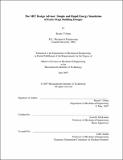| dc.contributor.advisor | Leon R. Glicksman. | en_US |
| dc.contributor.author | Urban, Bryan J. (Bryan James) | en_US |
| dc.contributor.other | Massachusetts Institute of Technology. Dept. of Mechanical Engineering. | en_US |
| dc.date.accessioned | 2008-09-02T17:52:03Z | |
| dc.date.available | 2008-09-02T17:52:03Z | |
| dc.date.copyright | 2007 | en_US |
| dc.date.issued | 2007 | en_US |
| dc.identifier.uri | http://hdl.handle.net/1721.1/42032 | |
| dc.description | Thesis (S.M.)--Massachusetts Institute of Technology, Dept. of Mechanical Engineering, 2007. | en_US |
| dc.description | This electronic version was submitted by the student author. The certified thesis is available in the Institute Archives and Special Collections. | en_US |
| dc.description | Includes bibliographical references (p. 173-177). | en_US |
| dc.description.abstract | Simulation tools, when applied early in the design process, can considerably reduce the energy demand of newly constructed buildings. For a simulation tool to assist with design, it must be easy to use, provide feedback quickly, and allow rapid comparisons. Most existing tools do not meet these needs, usually because they were intended for modeling finalized building designs. Often there is no user interface, and it can take hours or days to prepare, run, and interpret results. Such tools are too sophisticated for design purposes. In this document the MIT Design Advisor is presented as a simple and rapid building energy simulation tool, developed specifically for architects and building designers. Conceptual building designs can be modeled quickly and without formal training. Results are interpreted graphically and displayed to the user in a simple user interface. Side-by-side comparisons of building designs can be made, allowing users to quickly learn which building components have the biggest impact on energy consumption (heating, cooling, and lighting), indoor daylight levels, and thermal comfort. User-specified building parameters are used together with local weather data to predict monthly and annual energy use. The heat transfer model used to make the energy predictions is explained in detail in this thesis. Calculation methods are given and validated. Agreement with existing models is quite good. The MIT Design Advisor is available at http://designadvisor.mit.edu. | en_US |
| dc.description.statementofresponsibility | by Bryan J. Urban. | en_US |
| dc.format.extent | 177 p. | en_US |
| dc.language.iso | eng | en_US |
| dc.publisher | Massachusetts Institute of Technology | en_US |
| dc.rights | M.I.T. theses are protected by
copyright. They may be viewed from this source for any purpose, but
reproduction or distribution in any format is prohibited without written
permission. See provided URL for inquiries about permission. | en_US |
| dc.rights.uri | http://dspace.mit.edu/handle/1721.1/7582 | en_US |
| dc.subject | Mechanical Engineering. | en_US |
| dc.title | The MIT Design Advisor : simple and rapid energy simulation of early-stage building designs | en_US |
| dc.title.alternative | Simple and rapid energy simulation of early-stage building designs | en_US |
| dc.type | Thesis | en_US |
| dc.description.degree | S.M. | en_US |
| dc.contributor.department | Massachusetts Institute of Technology. Department of Mechanical Engineering | |
| dc.identifier.oclc | 228655906 | en_US |
